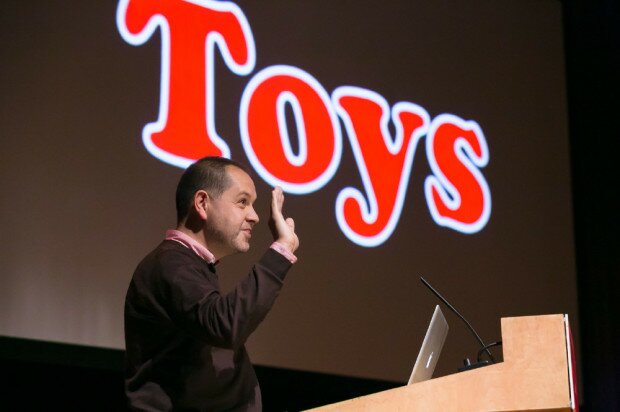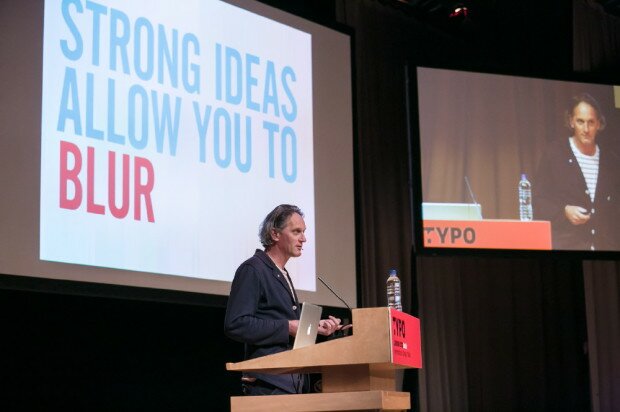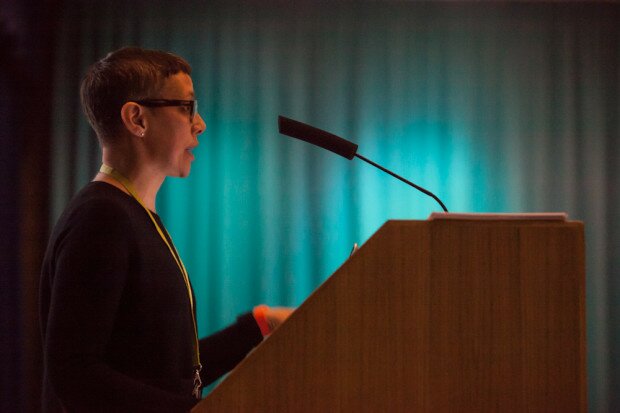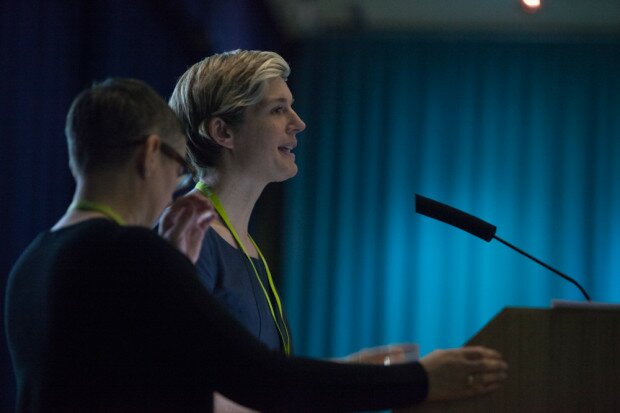Typo London Part Two: Interviews
Joseph Maduma
October 30th 2012As I mentioned in Part One of the Typo London write-up the conference did a first class job in encouraging the audience to mix and chat with the speakers, really delivering in a physical capacity this year’s theme of ‘Social’. Good Design had the honour of interviewing a handful of the speakers over the two days and here are their interviews printed in full. Covering the conference from the social-political angle of the theme ‘social’, I was keen to find out what good design meant to them and to ask them about an example of good design or a campaign that they thought was particularly effective in delivering social change.
Anthony Burrill

“Good Design is something that stands the test of time, something that has humanity and soul”
What does Good Design mean to you?
Good Design I think is something that lasts a long time. It’s got a kind of timeless quality, it’s something that communicates for as long as it’s around. Something that stands the test of time, something that has humanity and soul. Something that isn’t affected by fashion or by commerce.
Name a piece of good design, or campaign that you think was particularly effective in delivering or has the potential to deliver positive social change.
I think a good piece of design is quite a big thing, social media and the way that we can communicate with each other now through the internet, the way that it effects humans, we are only really beginning to understand that. The way that it’s changing our behaviour and the way we keep track of a wide group of friends, I think it’s going, as a piece of design, to have a massive effect on the future. I think that’s the biggest thing to effect social change.
Erik Kessels

“Benetton was one of the first brands that brought all kinds of ethnic people into adverts”
What does Good Design mean to you?
I think good design nowadays has a lot to do with the idea that is lying behind design. Because nowadays you see that design is so accessible to anybody, and everybody in a way can be a designer because all the techniques and the programmes are very easy to get. So it makes it even more important that you have a strong idea to start with because otherwise design just becomes a beautifully designed wrapping paper. You need to have something strong underneath and that is something that in the future designers will be able to sell because the practice of design will be a more and more common thing.
Name a piece of good design, or campaign that you think was particularly effective in delivering or has the potential to deliver positive social change.
When I think of one of the most effective campaigns of all time then I think of the campaign Oliviero Toscani did for Benetton. It was a very strong campaign because he brought some social issues into advertising and they did that for a long time. A lot of people have criticised that campaign but Benetton was one of the first brands that brought all kinds of ethnic people into adverts, one very nice example of how advertising and design can be a bit more meaningful to society. It doesn’t always have to but if you have the chance it’s a good medium to use. One example is the photograph that won a world press award of an Aids patient in bed, which ended up on the front cover of every newspaper. But only when Benetton took it and used it out of its context and placed it on a billboard was there much more discussion about the image, it was a bit displaced but it created far more rumours and discussion. Many of their campaigns have been memorable and that was one of the first ones an a big scale that brought social issues into the mass media.
Lucienne Roberts

“It’s about really pushing at the boundaries of what graphic design can do”
What does Good Design mean to you?
I guess it’s about change in some way but that assumes that there is something wrong with the way things are now. But usually it’s about helping, or educating, or informing, or making something more accessible. All those sort of standard things that you think of as good endeavours if you like, but crucially, and this is something that I talked about a bit yesterday that is a shift for me, it is about raising the quality of life in some way. So it’s the best that design can do and that’s not just about the message it is of course how it’s shaped – whether it’s delightful, beautiful, touching so you are really pushing at the boundaries of what graphic design can do.
Name a piece of good design, or campaign that you think was particularly effective in delivering or has the potential to deliver positive social change.
Ok what I’m going to talk about is the work of my colleague Bob Wilkinson who went off and did VSO in Nigeria as a graphic designer. He was producing materials about HIV and I think for him it was a real struggle because after working with me who’s a modernist (assuming that everything had to work in Helvetica) trying to get that to work in that environment became very difficult. And actually I think that’s very interesting because it raised loads and loads of issues about things that he and I talked about endlessly – clarity, form follows function and all this kind of stuff. The question was actually whether it worked. Of course it depends what you mean by form follows function, but if you like the sort of modernist stripping things back that he thought was bound to make things more accessible started to fail for him and he had to shift position a bit. I know for him it’s something that has become more and more of an interest and now actually he is doing an MA on that very subject which I think is remarkable actually looking back on his journey.
Rebecca Wright

“I think in a nutshell, good design improves the quality of life.”
What does Good Design mean to you?
I think in a nutshell, good design improves the quality of life. Or, improves quality of life. Whose life and to what degree depends on the problem, but I guess as a design educator I also really believe in the potential for design to create change and not just to answer existing problems but to identify problems, issues and areas where design can be used to improve our lives. So for me I think as an educator it’s really about how students are spotting opportunities that are available to designers and how pro-active they are in starting to address those issues and those gaps.
Name a piece of good design, or campaign that you think was particularly effective in delivering or has the potential to deliver positive social change.
What they observed was that every day we are swiping our cards when we use the London Underground to give money, but we’re paying for a ticket. What would happen if what we could do was add 1p voluntarily by selecting a specific marked gate to go through on certain days and that can then go to charity. It is spotting something, a system that actually involves no change in behaviour but has the cumulative effect of greater change as a possibility. Now of course it’s all hypothetical because there are a lot of pragmatic issues why it’s not possible. However they’ve worked with London Transport and spoken to the Mayor’s office about this and there was a really positive response. They were winners of the RSA prize and they achieved press interest.
It’s not a project that’s going forward into production because actually the system of how we are going to pay for our travel is going to change anyway and London Transport were quite up-front about that. But it’s put the idea into the minds of people who do have the power to think about how we pay for things. It explores the way in which you can capture existing behaviour and through design start to focus that on change, so for me that’s a really good example of design for social good.